'Constant Directivity' explained, so the horns above (probably) have more control over a wider, flatter BW than the inexpensive horns Wayne uses (used? I'm decades behind paying attention and he apparently no longer lists the horn models to research).
I have the cousin horns... the 500 series. It seems the 500 horn sites between these two as far as what the vert does.I ran out of time to edit the previous message. Here was my edit:
Obviously the various JBL monitors share common DNA, and it is particularly obvious with the JBL 4367 and the JBL 708P.
In many respects, the 708P is a miniature version of the 4367.
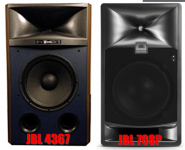
Here's a pic where I shrunk the 4367 by 50%, to show how the dimensions compare.
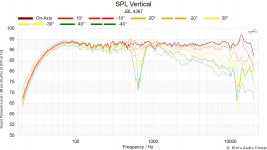
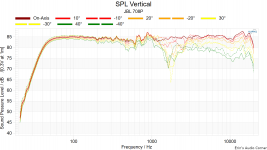
Here are the vertical polars of the JBL 4367 and the JBL 708P.
In the vertical polars, it's obvious that the smaller size of the 708P has moved the off axis dip an octave higher. There are a few things that may not be as obvious. The center-to-center spacing of the 708P is a full wavelength at the crossover frequency. The center to center spacing of the 4367 is eight tenths of a wavelength at the crossover frequency.
I wish that I could point to one of these designs and declare that they're superior, but there's no obvious winner:
* The 708P, with it's wider vertical beamwidth, has a smoother transition from the woofer to the tweeter.
* The 4367, with it's narrower vertical beamwidth, will be less likely to trigger reflections off the floor and the ceiling. From 2khz to 20khz, the JBL 4367 is radiating about half as much energy into the floor and the ceiling than the JBL 708P.
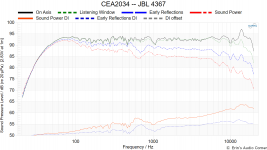
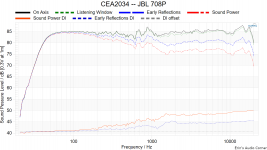
Looking at the spinoramas, both of them have a lot to like. The 4367 goes lower but the 708Ps are smoother.
I have to tilt my 580's just right for the LP to control how much ceiling they get.
Thanks very much for that, GM. Just the kind of layman's explanation I needed. Cheers.'Constant Directivity' explained, so the horns above (probably) have more control over a wider, flatter BW than the inexpensive horns Wayne uses (used? I'm decades behind paying attention and he apparently no longer lists the horn models to research).
This is the one he has used in his kits for a long time now'Constant Directivity' explained, so the horns above (probably) have more control over a wider, flatter BW than the inexpensive horns Wayne uses (used? I'm decades behind paying attention and he apparently no longer lists the horn models to research).
http://www.pispeakers.com/catalog/product_info.php?products_id=276
https://audioroundtable.com/forum/index.php?t=msg&th=17246
Where can we find this waveguide? I mean 4367's waveguide.The tweeter used to cost around $1600 a pair in 2017, it's down to $720 a pair now.
There's no listed price for the waveguide, but they're available. I'd guess about $300 a pair.
The woofer is the easy part, plenty of candidates for about $600 a pair.
Cabinet will be about $300 a pair.
The trick will be finding the crossover schematic.
Should be possible to clone them for about 15% of the retail price.
Where can we find this waveguide? I mean 4367's waveguide.
https://reconingspeakers.com/products-page/jbl-synthesis-4367-horn-111-0013-001/
Hi Patrick,
While l find this thread interesting reading without some direct listening and measurements of your own it’s supposition to draw subjective conclusions based on third party measurements.
There are simply too many unknown unknowns and differing opinions to make a conclusions or predictions. Opinions based on opinions make interesting conversations but they are of no real value in obtaining high quality sound reproduction imho (yes that’s an odd bit of grammar. It’s an lanisam)
You have to buy the hardware and actually use it to obtain your own evidence to support any form proven of hypothesis. If your interested l am currently looking a number of M2 horn measurements with different compression drivers over on the LHS website. I am also planning more off axis measurements.
What we do know is that depending on the room acoustics the M2 horn benefits from a 1 db per octave fall in the response from 1.5 to 2Khertz subject to the room acoustics. Your age and your hearing loss at certain frequencies will also have bearing on this. I know that because l was told so by Greg Timbers (retired JBL engineer of 43 years with JBL) He was responsible for the 4367. Greg’s comments are that the M2 horn with a flat response will kill you!
Fact.
A listeners age and the effect of age related hearing loss will also influence their subjective perceptions. Do not understand the impact of hearing loss. It’s real. This goes someway towards varying subjectivity,
Back to my point above:
This is because the real reverberation time of a domestic listening room can be sub optimal or too long at high frequencies compared to lower frequencies. So you get a build up of high frequency energy in the human ear which detects the additional delayed indirect sound pathways due to the wide coverage angles of these M2 horns. Ethan Winer has been preaching this for years and years.
A standard frequency response measurement will not tell you this because it’s a snap shot of the response at a given instant in time. It means little in terms of your subjective perceptions in a real domestic living space.
https://ethanwiner.com/acoustics.html
In some loudspeaker measurements this is referred to the listening window measurement. But it’s the reflectivity and absorption coefficient of the rooms surfaces that impacts and is influencing the subjectivity at high frequencies. Not the loudspeaker directivity as such.
None of this is rocket science.
In simple terms if you put the M2 set of monitors on the stage of a concert hall with recognised acoustics your subjective feedback would be very favourable. But take the M2 and put it in your living room with flat walls and glass windows and your subjective feedback might be so so.
For this reason some cd horn loudspeakers work quite effectively when positioned on the corners. This is because of the reflection angles work in favour of the reflected sound. The loudspeaker can emit its wider arch of coverage angle without those early reflections off the side walls normally associated with placement near a side wall at one end of the room. It’s these short reflections that create the perception of apparent high frequency brightness. This can also be prevalent at other frequencies above 1.5-2Khertz.
l hope this brings you some closure on the subject of cd horn design versus subjective observations.
Ian
http://www.audioheritage.org/vbulle...-diy-passive-crossover-thread-from-down-under
While l find this thread interesting reading without some direct listening and measurements of your own it’s supposition to draw subjective conclusions based on third party measurements.
There are simply too many unknown unknowns and differing opinions to make a conclusions or predictions. Opinions based on opinions make interesting conversations but they are of no real value in obtaining high quality sound reproduction imho (yes that’s an odd bit of grammar. It’s an lanisam)
You have to buy the hardware and actually use it to obtain your own evidence to support any form proven of hypothesis. If your interested l am currently looking a number of M2 horn measurements with different compression drivers over on the LHS website. I am also planning more off axis measurements.
What we do know is that depending on the room acoustics the M2 horn benefits from a 1 db per octave fall in the response from 1.5 to 2Khertz subject to the room acoustics. Your age and your hearing loss at certain frequencies will also have bearing on this. I know that because l was told so by Greg Timbers (retired JBL engineer of 43 years with JBL) He was responsible for the 4367. Greg’s comments are that the M2 horn with a flat response will kill you!
Fact.
A listeners age and the effect of age related hearing loss will also influence their subjective perceptions. Do not understand the impact of hearing loss. It’s real. This goes someway towards varying subjectivity,
Back to my point above:
This is because the real reverberation time of a domestic listening room can be sub optimal or too long at high frequencies compared to lower frequencies. So you get a build up of high frequency energy in the human ear which detects the additional delayed indirect sound pathways due to the wide coverage angles of these M2 horns. Ethan Winer has been preaching this for years and years.
A standard frequency response measurement will not tell you this because it’s a snap shot of the response at a given instant in time. It means little in terms of your subjective perceptions in a real domestic living space.
https://ethanwiner.com/acoustics.html
In some loudspeaker measurements this is referred to the listening window measurement. But it’s the reflectivity and absorption coefficient of the rooms surfaces that impacts and is influencing the subjectivity at high frequencies. Not the loudspeaker directivity as such.
None of this is rocket science.
In simple terms if you put the M2 set of monitors on the stage of a concert hall with recognised acoustics your subjective feedback would be very favourable. But take the M2 and put it in your living room with flat walls and glass windows and your subjective feedback might be so so.
For this reason some cd horn loudspeakers work quite effectively when positioned on the corners. This is because of the reflection angles work in favour of the reflected sound. The loudspeaker can emit its wider arch of coverage angle without those early reflections off the side walls normally associated with placement near a side wall at one end of the room. It’s these short reflections that create the perception of apparent high frequency brightness. This can also be prevalent at other frequencies above 1.5-2Khertz.
l hope this brings you some closure on the subject of cd horn design versus subjective observations.
Ian
http://www.audioheritage.org/vbulle...-diy-passive-crossover-thread-from-down-under
Last edited:
"This horn costs $525 each plus shipping."
More expensive than M2 Waveguide!
I guess M2 horn is claimed to be subjectively brighter mostly because of wider vertical dispersion. Domestic ceiling is usually untreated unlike professional studio space where at least the cloud exists. In my theory (and based on my experience), direct radiators are fine with wider vertical dispersion thanks to BBC dip.
That's an interesting point. Depending on the diametertand the geometry of the dome the dispersion will vary from one design to another. You can see this in the spec sheets.
Typically the tweeter/mid driver is closer to the flooring and side walls than the ceiling in a domestic living room. Assuming a 1 metre tower profile of a conventional two way direct radiator with crossover frequency of 2.8khertz with 2.4m ceilings. You can work out the reflections and the time arrival off those reflections.
The other other thing to understand is that for each doubling of distance sound in a free field space reduces 6 db. So if your 3 to 4 metres from the loudspeaker the reduction of the direct radiated sound will be 10 to 12 db. However, the sound level arrival and the delay from all other sources will be different and will be less and longer depending the delta of these differences.
There's no escaping this at home and its no surprise that a fully furnished room is going to be subjectively more favourable than an empty room. Fact.
To acoustically treat a room at home see John Darko's short film on acoustic treatment of his home listening room. It was a huge job and the cost was well beyond the price most people would contemplate.
But a fully furnished room with drapes, rugs and sofas does make a difference subjectively.
Logically moving the loudspeaker and or the listening location is within your control. This will vary the mix of direct versus reflected sound reaching the listening position and your subjective impressions. Fact.
I need to read up on the REW analyser but it would be useful to measure the indirect sound of the M2 and compare to a conventional direct radiator two way loudspeaker. My hypothesis is that the increase in the total measured indirect sound in your home listening room from the M2 over the conventional two way direct radiator loudspeaker will track the EQ recommendation made by Greg Timbers l referred to above. Why? Because Harman have done the acoustic analysis and they know the impact of using the M2 type horn. This is one of the reasons why JBL do include a full room EQ suite of adjustments for the M2 and its smaller systems.
You can experiment with room EQ using the Dirac room correction offered in some consumer audio equipment and Minidsp. I would recommend that for anyone contemplating a more factual understanding on the subject of the acoustic impact of the M2 horn.
Typically the tweeter/mid driver is closer to the flooring and side walls than the ceiling in a domestic living room. Assuming a 1 metre tower profile of a conventional two way direct radiator with crossover frequency of 2.8khertz with 2.4m ceilings. You can work out the reflections and the time arrival off those reflections.
The other other thing to understand is that for each doubling of distance sound in a free field space reduces 6 db. So if your 3 to 4 metres from the loudspeaker the reduction of the direct radiated sound will be 10 to 12 db. However, the sound level arrival and the delay from all other sources will be different and will be less and longer depending the delta of these differences.
There's no escaping this at home and its no surprise that a fully furnished room is going to be subjectively more favourable than an empty room. Fact.
To acoustically treat a room at home see John Darko's short film on acoustic treatment of his home listening room. It was a huge job and the cost was well beyond the price most people would contemplate.
But a fully furnished room with drapes, rugs and sofas does make a difference subjectively.
Logically moving the loudspeaker and or the listening location is within your control. This will vary the mix of direct versus reflected sound reaching the listening position and your subjective impressions. Fact.
I need to read up on the REW analyser but it would be useful to measure the indirect sound of the M2 and compare to a conventional direct radiator two way loudspeaker. My hypothesis is that the increase in the total measured indirect sound in your home listening room from the M2 over the conventional two way direct radiator loudspeaker will track the EQ recommendation made by Greg Timbers l referred to above. Why? Because Harman have done the acoustic analysis and they know the impact of using the M2 type horn. This is one of the reasons why JBL do include a full room EQ suite of adjustments for the M2 and its smaller systems.
You can experiment with room EQ using the Dirac room correction offered in some consumer audio equipment and Minidsp. I would recommend that for anyone contemplating a more factual understanding on the subject of the acoustic impact of the M2 horn.
@Patrick Bateman :
Ended up with any specific conclusion about your "study " on the waveguides in the recent years ?
I was reading ( partially ) through some threads, mostly in the " poor man's M2 " stuff etc..
Still learning and i have no time right now to dive into Akabak/ATH design stuff etc ...
IIRC, you were discussing about the possibility of " constant cross section " through the waveguide to cater to a specific trait
( let's say wider horizontal patter like on the JBL's ) was that confirmed ?
Would seem rather logical to keep a constant cross section for the wavefront to keep together .
Also, was there any conclusion for the OS aka GeeLee style waveguide ? Seems very simple to design and use ( and prevent lots of HOMs etc.. )
if size is not issue ( although i'd guess then the spacing with the woofer is the limitation ? )
Ended up with any worthy candidate with your " X " style design to lower the spacing with the crossover woofer ?
Thanks for the update and sharing
Ended up with any specific conclusion about your "study " on the waveguides in the recent years ?
I was reading ( partially ) through some threads, mostly in the " poor man's M2 " stuff etc..
Still learning and i have no time right now to dive into Akabak/ATH design stuff etc ...
IIRC, you were discussing about the possibility of " constant cross section " through the waveguide to cater to a specific trait
( let's say wider horizontal patter like on the JBL's ) was that confirmed ?
Would seem rather logical to keep a constant cross section for the wavefront to keep together .
Also, was there any conclusion for the OS aka GeeLee style waveguide ? Seems very simple to design and use ( and prevent lots of HOMs etc.. )
if size is not issue ( although i'd guess then the spacing with the woofer is the limitation ? )
Ended up with any worthy candidate with your " X " style design to lower the spacing with the crossover woofer ?
Thanks for the update and sharing
AHAHAH. Well that tends to happen a lot. We'd like something more " complex " or interesting to be the solution. lol
Good thing though because they seem quite easy to handle. IIRC from the little i've read from him, he did test and play with most of the usable "shapes" before coming to the OS conclusion.
Good thing though because they seem quite easy to handle. IIRC from the little i've read from him, he did test and play with most of the usable "shapes" before coming to the OS conclusion.
This is a relative part of the compromise so it depends entirely on how you mean it. However I think the answer would be no, the spacing gets more attention than it deserves. It is an important factor but it doesn't have to be as small as people make out. I'd rather not needlessly compromise the waveguide.i'd guess then the spacing with the woofer is the limitation ?
yes good points mates 
appreciated
So then if i may ask, what kind of distances are we talking about here ?
I am getting a bit mixed up with the spacing when horn/waveguides are used ...
It is from the center of the mouth ( end of horn/guide ? ) to the center of the woofer driver ?
that would still need to be within 1/4 wavelengths or ?
Also, if i may ...again ... lol
I'd like to learn how drivers behave at high frequency in respect to their beamwidth .. like for example
using a 12~15" woofer to drive up to 1KHz... intuitively think it would be starting to beam real bad at this point ,
but is that even a bad thing ? or it it used in the design to try and " match " the directivity of the waveguide/HF unit ?
thanks again all
appreciated
So then if i may ask, what kind of distances are we talking about here ?
I am getting a bit mixed up with the spacing when horn/waveguides are used ...
It is from the center of the mouth ( end of horn/guide ? ) to the center of the woofer driver ?
that would still need to be within 1/4 wavelengths or ?
Also, if i may ...again ... lol
I'd like to learn how drivers behave at high frequency in respect to their beamwidth .. like for example
using a 12~15" woofer to drive up to 1KHz... intuitively think it would be starting to beam real bad at this point ,
but is that even a bad thing ? or it it used in the design to try and " match " the directivity of the waveguide/HF unit ?
thanks again all
- Home
- Loudspeakers
- Multi-Way
- Highly Asymmetrical Waveguides